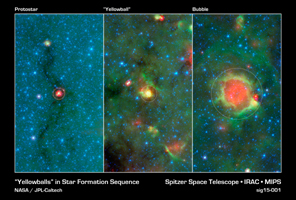
Poster Version
Click on the image for larger view
Download the full resolution TIFF fileThis series of images show three evolutionary phases of massive star formation, as pictured in infrared images from NASA's Spitzer Space Telescope. The stars start out in thick cocoon of dust (left), evolve into hotter features dubbed "yellowballs" (center); and finally, blow out cavities in the surrounding dust and gas, resulting in green-rimmed bubbles with red centers (right). The process shown here takes roughly a million years. Even the oldest phase shown here is fairly young, as massive stars live a few million years. Eventually, the stars will migrate away from their birth clouds.
In this image, infrared light of 3.6 microns is blue; 8-micron light is green; and 24-micron light is red.
NASA's Jet Propulsion Laboratory, Pasadena, California, manages the Spitzer Space Telescope mission for NASA's Science Mission Directorate, Washington. Science operations are conducted at the Spitzer Science Center at the California Institute of Technology in Pasadena. Spacecraft operations are based at Lockheed Martin Space Systems Company, Littleton, Colorado. Data are archived at the Infrared Science Archive housed at the Infrared Processing and Analysis Center at Caltech. Caltech manages JPL for NASA.
For more information about Spitzer, visit http://spitzer.caltech.edu and http://www.nasa.gov/spitzer.

